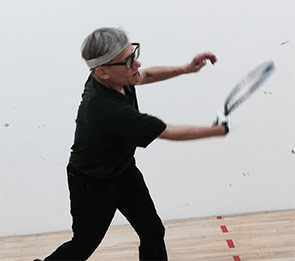Then his gym colleague, also a physics professor, suggested Reigstad “search for the best,” and that led him to Dr. Brasington at Washington University.
From the start, the patient was an active participant in treatment decisions. Dr. Brasington recalls that Reigstad responded well to first-line treatment with methotrexate. Together they negotiated dosage adjustments: After several months on 20 mg of MTX, Reigstad complained of nausea and Dr. Brasington reduced his dose to 17.5 mg. They negotiated a further reduction to 15 mg, at Reigstad’s request, on the condition that the dosage would be increased or switched to injectable form, or other options would be considered, such as biologics, if his condition worsened.
Within six months of beginning treatment with MTX, Reigstad’s hand swelling and pain had diminished enough to resume play. To do so, he still needed to make some adjustments to manage the pain. He asked a pro shop to increase the circumference of his racquet grip from 3 1/8″ to 10 1/2″, thus “inventing” his own orthotic grip. He steadily increased his workouts to make up for lost muscle mass, paid careful attention to self-care, and in 2011 placed fourth in the U.S. Open Racquetball Championships in the men’s 60–64-year-old division.
He now cheerfully says, “All these transitions enabled me to play racquetball nearly every day in 2014, sometimes against A-rated opponents who could be my grandsons, and, as Dr. B. says, ‘kick their asses!’”

Physician’s Lessons Learned
Dr. Brasington agrees that Reigstad is a remarkable person who is wholly engaged in his own care. He advises colleagues to attempt to understand, from the patient’s perspective, what problems the disease is causing and what changes the patient wants to see. He believes most patients are more concerned about function and quality of life than measurable indicators, such as radiographs, SED RTE, rheumatoid factor, RAPID 3s or their DAS scores. “But those things [function and quality of life] are not so easily measured,” he notes. “In this era of ‘treat to target,’ it’s important to recognize how much improving quality of life matters and that the patient can help us tell how they’re doing. So it’s a good idea to dig a little deeper, not make too many assumptions and to ask patients what they are hoping to achieve.”
Turning Losses into Assets
When asked what accounts for his resilience in dealing with RA, Reigstad, a Lutheran minister and a professor of philosophy at St. Louis University, notes that he has learned to look at the big picture of treatment, recovery and life. That entails, among other things, using the power of rest periods to enable daily activities, helping friends and loved ones understand the disabling fatigue crashes of RA, nurturing the enjoyment of self and finding a rheumatologist who’s a good match. Since our last interview, he’s also been dealing with osteoarthritis in his knee, but with the same characteristic optimism and purpose. “I always treat any illness, symptom or problem as something I can overcome,” he states. “My father died on my 9th birthday, and it took 20 years to get over that. Every other problem now seems like a piece of cake.”

